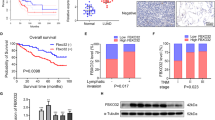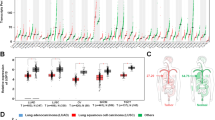Abstract
Lung carcinoma is the main reason for cancer-associated deaths in the world. In a previous study, FCH domain only 1 (FCHo1) which is managed by protein kinase B (AKT), was shown to be activated in lung cancer. FCHo1 knockdown has previously been shown to cause cell death in lung cancer. However, the specific roles of FCHo1 in lung carcinoma remain elusive. Herein, we propose that FCHo1’s intracellular mechanism targets the G1 to S phase transition, following the M phase. We demonstrated that F-BAR and mu homology domains exist separately in human lung tissues and that one truncated form is not detected in patients with lung cancer. Furthermore, quantitative global proteome analysis of FCHo1 indicated that the inhibition of G1/S phase transition and FCHo1 RNAi led to the death of cells in the G1/S phase. Noninvasive viral aerosol-mediated delivery of FCHo1 shRNA suppressed cancer progression in mice with non-small-cell lung cancer (NSCLC), suggesting that the delivery of FCHo1 shRNA could be a meaningful therapeutic strategy in lung cancer. Additional studies are needed to make clear the detailed mechanism of action of FCHo1.
This is a preview of subscription content, access via your institution
Access options
Subscribe to this journal
Receive 12 print issues and online access
$259.00 per year
only $21.58 per issue
Buy this article
- Purchase on Springer Link
- Instant access to full article PDF
Prices may be subject to local taxes which are calculated during checkout




Similar content being viewed by others
References
Henne WM, Boucrot E, Meinecke M, Evergren E, Vallis Y, Mittal R, et al. FCHo proteins are nucleators of clathrin-mediated endocytosis. Science 2010;328:1281–4.
Henne WM, Kent HM, Ford MGJ, Hegde BG, Daumke O, Butler PJG, et al. Structure and analysis of FCHo2F-BAR domain: a dimerizing and membrane recruitment module that effects membrane curvature. Structure 2007;15:839–52.
Lyszkiewicz M, Zietara N, Frey L, Pannicke U, Stern M, Liu Y, et al. Human FCHO1 deficiency reveals role for clathrin-mediated endocytosis in development and function of T cells. Nat Commun. 2020;11:1031.
Umasankar PK, Sanker S, Thieman JR, Chakraborty S, Wendland B, Tsang M, et al. Distinct and separable activities of the endocytic clathrin-coat components Fcho1/2 and AP-2 in developmental patterning. Nat Cell Biol. 2012;14:488–501.
Park S, Hong Y, Lee S, Lee AY, Tran Q, Lee H. et al. FCHO1560-571 peptide, a PKB kinase motif, inhibits tumor progression. Biochem Biophys Res Commun. 2020;528:478–484.
Aviner R, Shenoy A, Elroy-Stein O, Geiger T. Uncovering hidden layers of cell cycle regulation through integrative multi-omic analysis. PLoS Genet. 2015;11(10):e1005554.
Vakifahmetoglu H, Olsson M, Zhivotovsky B. Death through a tragedy: mitotic catastrophe. Cell Death Differ. 2008;15:1153–62.
Chieffi P, Aurora B. A new promising therapeutic target in cancer. Intractable Rare Dis Res. 2018;7:141–4.
McDonald NA, Takizawa Y, Feoktistova A, Xu P, Ohi MD, Vander Kooi CW, et al. The tubulation activity of a fission yeast F-BAR protein is dispensable for its function in cytokinesis. Cell Rep. 2016;14:534–46.
Finkel T, Hwang PM. The Krebs cycle meets the cell cycle: mitochondria and the G(1)-S transition. Proc Natl Acad Sci USA. 2009;106:11825–6.
Sugiyama M, Sakaue-Sawano A, Iimura T, Fukami K, Kitaguchi T, Kawakami K, et al. Illuminating cell-cycle progression in the developing zebrafish embryo. Proc Natl Acad Sci USA. 2009;106:20812–7.
Wragg JW, Roos L, Vucenovic D, Cvetesic N, Lenhard B, Mueller F. Zebrafish embryonic tissue differentiation is marked by concurrent cell cycle dynamic and gene promoter regulatory changes. 2020;48(15):8374-8392.
Bavetsias V, Linardopoulos S. Aurora kinase inhibitors: current status and outlook. Front Oncol. 2015;5:278.
Hong SH, Chang SH, Cho KC, Kim S, Park S, Lee AY, et al. Endoplasmic reticulum–Golgi intermediate compartment protein 3 knockdown suppresses lung cancer through endoplasmic reticulum stress-induced autophagy. Oncotarget 2016;7:65335–47.
Wisniewski JR, Zougman A, Nagaraj N, Mann M. Universal sample preparation method for proteome analysis. Nat Methods. 2009;6:359–62.
Hoerth P, Miller CA, Preckel T, Wenz C. Efficient fractionation and improved protein identification by peptide OFFGEL electrophoresis. Mol Cell Proteom. 2006;5:1968–74.
Searle BC. Scaffold: a bioinformatic tool for validating MS/MS-based proteomic studies. Proteomics 2010;10:1265–9.
Chang S-H, Hong S-H, Jiang H-L, Minai-Tehrani A, Yu K-N, Lee J-H, et al. GOLGA2/GM130, cis-Golgi matrix protein, is a novel target of anticancer gene therapy. Mol Ther. 2012;20:2052–63.
Hong S-H, Minai-Tehrani A, Chang S-H, Jiang H-L, Lee S, Lee A-Y, et al. Knockdown of the sodium-dependent phosphate co-transporter 2b (NPT2b) suppresses lung tumorigenesis. PLoS ONE. 2013;8:e77121.
Hong S-H, Park S-J, Lee S, Cho CS, Cho M-H. Aerosol gene delivery using viral vectors and cationic carriers for in vivo lung cancer therapy. Expert Opin Drug Deliv. 2015;12:977–91.
Islam MA, Shin J-Y, Yun C-H, Cho C-S, Seo HW, Chae C, et al. The effect of RNAi silencing of p62 using an osmotic polysorbitol transporter on autophagy and tumorigenesis in lungs of K-ras(LA1) mice. Biomaterials 2014;35:1584–96.
Acknowledgements
This work was supported by BK21 PLUS Program for Creative Veterinary Science Research. This work was financially supported by a research fund from Chungnam National University (grant to JP).
Author information
Authors and Affiliations
Contributions
SP, JP, and MHC designed the entire study and wrote the manuscript. SP and AYL performed experiments including immunoprecipitations, live cell imaging, RTCA proliferation assays, lentivirus production, and DNA construct cloning, and contributed equally to the data interpretation and the writing and preparation of the manuscript. AYL, SK, and SHH performed the in vivo experiment. KCC and JHJ performed the proteomics analysis and contributed to data interpretation and manuscript preparation. JP, KPK, and MHC jointly supervised the study. All authors discussed the results and reviewed the manuscript.
Corresponding authors
Ethics declarations
Competing interests
The authors declare no competing interests.
Additional information
Publisher’s note Springer Nature remains neutral with regard to jurisdictional claims in published maps and institutional affiliations.
Supplementary information
Rights and permissions
About this article
Cite this article
Park, S., Lee, A.Y., Cho, KC. et al. FCH domain only 1 (FCHo1), a potential new biomarker for lung cancer. Cancer Gene Ther 29, 901–907 (2022). https://doi.org/10.1038/s41417-021-00376-8
Received:
Revised:
Accepted:
Published:
Issue Date:
DOI: https://doi.org/10.1038/s41417-021-00376-8
This article is cited by
-
Genomic characteristics of two breast malignant phyllodes tumors during pregnancy and lactation identified through whole-exome sequencing
Orphanet Journal of Rare Diseases (2022)



